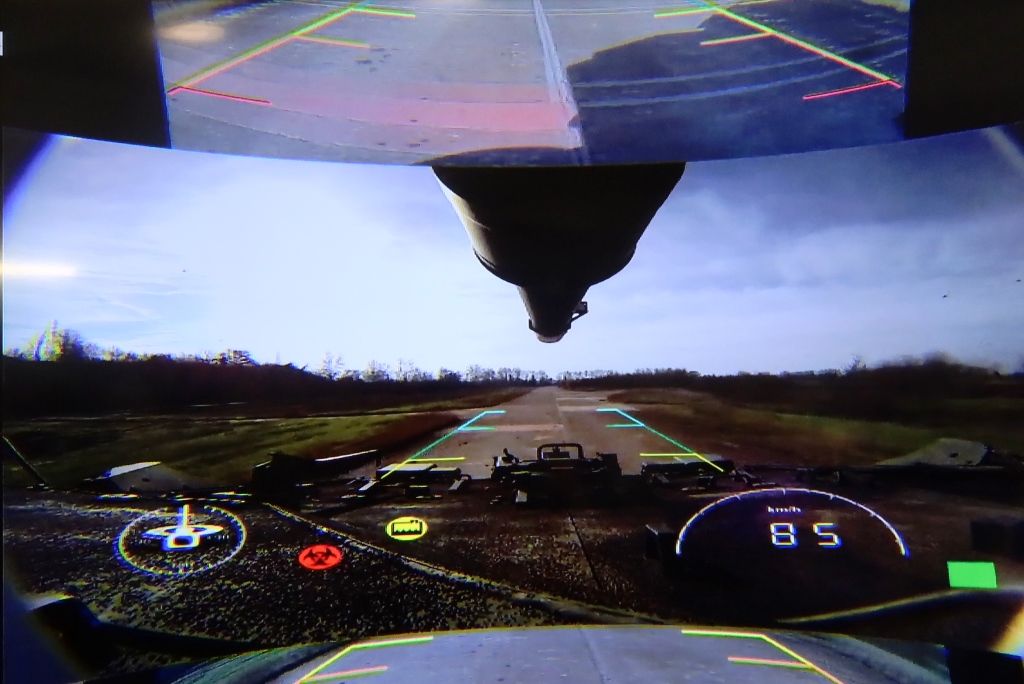
DCube details VUHLCAN driver vision system
DCube, an Italian defence company specialising in advanced vision systems for armoured vehicles and other combat platforms has detailed its VUHLCAN (Vision Under Hatch for Land Carriers through Assisted Navigation) driver’s vision system in an interview with EDR On-Line

VUHLCAN was designed to provide armoured vehicle drivers with a level of ‘driving comfort’ comparable to a natural driving experience, whatever the orientation of the head. It operates both at day and at night whilst driving with hatches closed through cameras situated around the vehicle and an immersive heads-up display (HUD). “The multi-sensor suites provide imagery to a computer that processes the video footage in close to real time,” Giuliano Borghi, Vice President of Engineering and Design at DCube representative told EDR On-Line. However, not all of the imagery is sent to the driver’s HUD; only that which is in the driver’s field of vision, which is informed by the orientation of the driver’s head.
“There are three main challenges with typical driver vision systems; the first is that they use flat panel displays to present the video feeds, which makes it difficult for the driver to see everything easily. The second is latency – the time difference between movement and when your brain sees something needs to be minimal, otherwise it can cause nausea. The third is the role of depth perception or stereovision, which is hard to achieve without combining images from two sensors,” Borghi explained.

The VUHLCAN system consists of combined day and night/thermal cameras located at the front of the vehicle, one set on either side and a further set at the rear. The cameras at the front of the vehicle provide a 90°-120° horizontal field of view to the front and rear, with 50° at the sides. The vertical fields of view are 70° – 90° all round. The images are connected together using software designed by DCube specifically to minimise latency so that as the driver’s head moves there is no noticeable delay when switching from one set of cameras to another.
This means that by a simple move of the head, the driver can see to the vehicle front or sides without having to select a camera. “The result is a natural driving position, wherever the driver’s head is,” Borghi added.
The cameras positioning is the result of different requirements: The main HD camera pointing forward provides driving vision, even at high speeds thanks to a High-Definition Video Signal. A further front camera points downwards and provides a forward proximity vision to look for the presence of obstacles. There are also side cameras that point forward to provide a view of the vehicle’s wheels, which enables the driver to manoeuvre in narrow spaces. Finally, the rear camera provides rear-view driving vision.
Extensive tests were conducted with VUHLCAN at day and night, on- and off-road. Over 2,000 km were driven with the system fitted to an armoured vehicle. The design of the system was completed between 2018 and 2020, at which point a project finalisation contract was signed with the Italian Army. Five systems were delivered by 2022 for use on the Centauro 2 8×8 mobile gun system. A further contract for 150 systems is expected in 2024, and talks are underway for possible applications on the rest of the Italian Army’s vehicles.

DCube is also working on two other systems; Multispectral Aiming High Resolution System (MAHRS) is an optronic aim-assist system designed for machine guns. It can be installed on ships, armoured vehicles or helicopters and provides remote aim-assist for gunners through a monocular or binocular display. It increases first round accuracy and enables the gunner to fire from a protected position. The third is Shielding Highly Integrated Vehicular Assembly (SHIVA), which is a sensor fusion system designed to provide greater situational awareness by combining the data collected by a variety of sensors and communicating their outputs to the vehicle crew.
Armed forces are increasingly seeking out ways to improve crew situational awareness through advanced computing power and by combining multiple sensor types. It can increase vehicle survivability by improving a crew’s perception of what is happening outside of the vehicle. The alternative is for the commander or driver to expose their head and shoulders outside of the vehicle. Additionally, these systems improve the ability to navigate challenging terrain and urban environments, which are notoriously difficult for large AFVs.
Photos courtesy DCube and P. Valpolini
